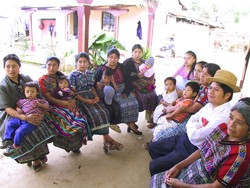
Challenge
For decades, studies have shown a high demand among Guatemalan couples for resources to help them make informed decisions and follow through on planning the number and spacing of their children. Yet, until five years ago, information on reproductive health and family planning was very difficult to find in Guatemala, particularly in rural areas. Political, religious, and cultural barriers that have long defined social behaviors stood in the way of couples’ ability to protect and plan their family’s health and wellbeing. This lack of access to family planning information and services brought Guatemala to its current position: it has highest fertility rates in the hemisphere.
Initiative
In 2000, USAID supported Guatemala’s health ministry in an historic step to position family planning for birth spacing as a key component of a new reproductive health plan. The initiative provides information and services to help couples make informed decisions. In its first year, the program trained more than 9,500 advisers in counseling techniques and safe contraceptive use for birth spacing. It established a solid infrastructure to get safe contraceptives to couples who opted to use them. This combination of thoughtful counseling, clear information, effective product supply, and accessible delivery points has enhanced decision-making among rural and urban couples for the first time in Guatemala’s history.
Results
Awareness of family planning has risen — 93.3 percent of women in union know about contraceptives and men are now more involved in decision-making. In Guatemala, contraceptive use increased from 23.2 percent in 1987 to 43.3 percent in 2002. Fertility rates fell from 5.1 children per woman in 1999 to 4.4 in 2002. The health ministry is now the largest contributor to family planning, providing 57 percent of contraceptives distributed nationwide, including to rural and indigenous populations previously not served. The program identified and responded to a demand for information and services for birth spacing, bringing welcome changes to thousands of families.







Comment
Make a general inquiry or suggest an improvement.